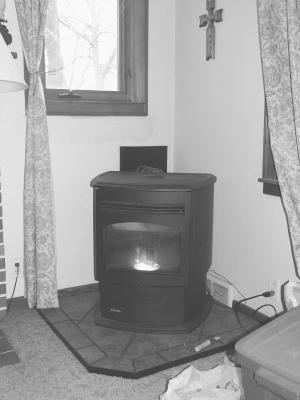2006 - Volume #30, Issue #3, Page #13
[ Sample Stories From This Issue | List of All Stories In This Issue | Print this story
| Read this issue]
Advice From A Corn Stove Owner
 |
Corn stoves are not the answer for everyone, but I do think they could work well for many farmers and farm families.
Here's what I see as the advantages of operating a corn stove:
• You raise the corn, so there's plenty of corn. It feels good to use corn to heat your house. • You can heat your house to 70 degrees and not feel guilty about it.
• You can save money, based on how often you use your corn stove.
• Corn stoves work really well if someone is in or around the house all day.
Here are some of the things you have to plan for to use a corn stove:
• You make a commitment when you decide to burn corn. It's a little like owning a puppy - you have to clean up after it. At a minimum, the clinkers should be cleaned out of the fire pot every day. You also have to make sure the air holes are cleaned out to keep the fire going strong. I use gloves, steel wool, glass cleaner, a large nail, a wet/dry vacuum and paper towels every day to clean our stove. We bought a little case where we store everything near the stove. We use about a bushel of corn daily plus a half cup of wood pellets to help get the fire going.
• You have to come up with a way to store and move corn. We put corn in large plastic totes that weigh about 60 lbs. and carry them into our home one at a time as needed. We use a two-quart pitcher to refill the stove's bin. It's not that hard.
• Corn stoves need air. A small fan runs continuously while the stove is on to keep the airflow going. If your electricity goes off, you need a battery or generator to run the fan to still have heat.
• Some communities have special requirements about the location of your stovepipe and stove. You also need heat-resistant flooring under the stove.
• The more you learn before installing a corn stove, furnace or boiler, the happier you'll be with the outcome.
Are corn stoves for everyone? No, but unless things change drastically, the Johnson house will continue to heat with corn.

Click here to download page story appeared in.

Click here to read entire issue
To read the rest of this story, download this issue below or click here to register with your account number.




